|
|
|
Sort Order |
|
|
|
Items / Page
|
|
|
|
|
|
|
| Srl | Item |
| 1 |
ID:
125136
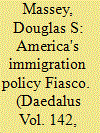

|
|
|
|
|
| Publication |
2013.
|
| Summary/Abstract |
In this essay I discuss how and why U.S. policies intended to stop Latin American immigration to the United States not only failed, but proved counterproductive by ultimately accelerating the rate of both documented and undocumented migration from Mexico and Central America to the United States. As a result, the Latino population grew much faster than demographers had originally projected and the undocumented population grew to an unprecedented size. Mass illegality is now the greatest barrier to the successful integration of Latinos, and a pathway to legalization represents a critical policy challenge. If U.S. policy-makers wish to avoid the failures of the past, they must shift from a goal of immigration suppression to one of immigration management within an increasingly integrated North American market.
|
|
|
|
|
|
|
|
|
|
|
|
|
|
|
|
| 2 |
ID:
125146
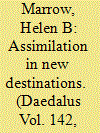

|
|
|
|
|
| Publication |
2013.
|
| Summary/Abstract |
This article outlines a long-term research agenda on immigrant assimilation by calling on scholars to be more explicit about how we model and measure assimilation, and to move away from previously aspatial approaches to the topic. After briefly overviewing the field, I draw on original qualitative data from a new immigrant destination region to highlight several places where I believe we scholars can better clarify definitions of and assumptions about assimilation, as well as choices about and interpretations of our data, to foster transparency and facilitate scholarly discovery. I conclude by arguing that scholars working in new immigrant destinations are well poised to examine how legal status - a key structural feature of the context of reception in a host society or locale - shapes assimilation processes and outcomes.
|
|
|
|
|
|
|
|
|
|
|
|
|
|
|
|
| 3 |
ID:
125143


|
|
|
|
|
| Publication |
2013.
|
| Summary/Abstract |
This article focuses on settlement trends of immigrants during the periods that bookend the twentieth century, both eras of mass migration. It compares settlement patterns in both periods, describing old and new gateways, the growth of the immigrant population, and geographic concentration and dispersion. Historically, immigrants have been highly concentrated in a few places. Between 1930 and 1990, more than half of all immigrants lived in just five metropolitan areas. Since then, the share of these few destinations has declined, as immigrants have made their way to new metro areas, particularly in the South and West. During the same period, immigrants began to choose the suburbs over cities, following the decentralization of jobs and the movement of opportunities to suburban areas. There are now more immigrants in U.S. suburban areas than cities.
|
|
|
|
|
|
|
|
|
|
|
|
|
|
|
|
| 4 |
ID:
125138
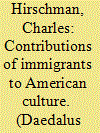

|
|
|
|
|
| Publication |
2013.
|
| Summary/Abstract |
The standard account of American immigration focuses on the acculturation and assimilation of immigrants and their children to American society. This analysis typically ignores the significant contributions of immigrants to the creation of American culture through the performing arts, sciences, and other cultural pursuits. Immigrants and their children are not born with more creative talents than native-born citizens, but their selectivity and marginality may have pushed and pulled those with ability into high-risk career paths that reward creative work. The presence of large numbers of talented immigrants in Hollywood, academia, and the high-tech industries has pushed American institutions to be more meritocratic and open to innovation than they would be otherwise.
|
|
|
|
|
|
|
|
|
|
|
|
|
|
|
|
| 5 |
ID:
125153


|
|
|
|
|
| Publication |
2013.
|
| Summary/Abstract |
Over the last few decades, and particularly after 9/11, we have witnessed the increasing criminalization of immigrants in the United States. Changing policies have subjected immigrants to intensified apprehension and detention programs. This essay provides an overview of the context and policies that have produced the rising criminalization of immigrants. We draw on the institutional theory of migration to understand the business of detention centers and the construction of the immigration-industrial complex. We link government contracts and private corporations in the formation of the immigration-industrial complex, highlighting the increasing profits that private corporations are making through the detention of immigrants. We conclude with a discussion of how the privatization of detention centers is part of a larger trend in which basic functions of societal institutions are being farmed out to private corporations with little consideration for basic human rights.
|
|
|
|
|
|
|
|
|
|
|
|
|
|
|
|
| 6 |
ID:
125152


|
|
|
|
|
| Publication |
2013.
|
| Summary/Abstract |
The focus on undocumented immigrants in contemporary U.S. immigration debates, often at the expense of other immigration issues, has led to an illegality trap. This situation has serious negative consequences for both U.S. immigration policy and immigrants, including an overwhelming emphasis on enforcement; legislative gridlock and the failure of comprehensive immigration reform; constitutional conflict resulting from tensions between national, state, and local approaches to dealing with undocumented immigration; and the puzzling absence of federal policies addressing immigrant integration. This essay argues for a reframing of "illegality" as a contingent rather than categorical status, building on the insights of Plyler v. Doe and notions of implied contract and attachment to U.S. society. Doing so, we contend, will shift the terms of the immigration debate, enabling more fruitful policy discussions about both immigration and immigrant integration.
|
|
|
|
|
|
|
|
|
|
|
|
|
|
|
|
| 7 |
ID:
125144


|
|
|
|
|
| Publication |
2013.
|
| Summary/Abstract |
Using New York City as an example, this essay examines how American cities that have a long and continuous history of absorbing immigrants develop welcoming institutions and policies for current immigrants and their children. Cities such as Chicago, San Francisco, and New York have been gateway cities for many previous waves of immigrants and continue to absorb new immigrants today. The ethnic conflicts and accommodations of the nineteenth and twentieth centuries continue to shape the context of reception of today's immigrants. In contrast to "new destinations," which in recent years have often been centers of anti-immigrant sentiment and nativist local social policies, New York has generally adopted policies designed to include and accommodate new immigrants, as well as repurposing institutions that served earlier European immigrants and native-born African Americans and Puerto Ricans. The continuing significance of race in the city is counterbalanced in the lives of immigrants by a relative lack of nativism and an openness to incorporating immigrants.
|
|
|
|
|
|
|
|
|
|
|
|
|
|
|
|
| 8 |
ID:
125148
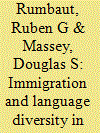

|
|
|
|
|
| Publication |
2013.
|
| Summary/Abstract |
While the United States historically has been a polyglot nation characterized by great linguistic diversity, it has also been a zone of language extinction in which immigrant tongues fade and are replaced by monolingual English within a few generations. In 1910, 10 million people reported a mother tongue other than English, notably German, Italian, Yiddish, and Polish. The subsequent end of mass immigration from Europe led to a waning of language diversity and the most linguistically homogenous era in American history. But the revival of immigration after 1970 propelled the United States back toward its historical norm. By 2010, 60 million people (a fifth of the population) spoke a non-English language, especially Spanish. In this essay, we assess the effect of new waves of immigration on language diversity in the United States, map its evolution demographically and geographically, and consider what linguistic patterns are likely to persist and prevail in the twenty-first century.
|
|
|
|
|
|
|
|
|
|
|
|
|
|
|
|
| 9 |
ID:
125147


|
|
|
|
|
| Publication |
2013.
|
| Summary/Abstract |
The "color line" has long served as a metaphor for the starkness of black/white relations in the United States. Yet post-1965 increases in U.S. immigration have brought millions whose ethnoracial status seems neither black nor white, boosting ethnoracial diversity and potentially changing the color line. After reviewing past and current conceptualizations of America's racial divide(s), we ask what recent trends in intermarriage and multiracial identification - both indicators of ethnoracial boundary dissolution - reveal about ethnoracial color lines in today's immigrant America. We note that rises in intermarriage and multiracial identification have emerged more strongly among Asians and Latinos than blacks and in more diverse metropolitan areas. Moreover, these tendencies are larger than would be expected based solely on shifts in the relative sizes of ethnoracial groups, suggesting that immigrationgenerated diversity is associated with cultural change that is dissolving ethnoracial barriers - but more so for immigrant groups than blacks.
|
|
|
|
|
|
|
|
|
|
|
|
|
|
|
|
| 10 |
ID:
125137


|
|
|
|
|
| Publication |
2013.
|
| Summary/Abstract |
Immigration has remade and changed American society since the nation's founding, and an understanding of the past can help illuminate the immigrant experience in the present. This essay focuses on three central questions: What is new about the most recent immigrant wave? What represents continuity or parallels with the past? And how have migrant inflows in earlier historical periods changed the social, economic, political, and cultural contexts that now greet - and shape the experiences of - the latest arrivals? In examining these questions, the focus is on the last great wave of immigration at the turn of the twentieth century, in which the newcomers were mainly from Eastern, Southern, and Central Europe, and the contemporary inflow, from the late 1960s to the present, which is made up overwhelmingly of people from Latin America, Asia, and the Caribbean.
|
|
|
|
|
|
|
|
|
|
|
|
|
|
|
|
| 11 |
ID:
125154
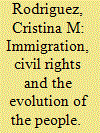

|
|
|
|
|
| Publication |
2013.
|
| Summary/Abstract |
In considering what it means to treat immigration as a "civil rights" matter, I identify two frameworks for analysis. The first, universalistic in nature, emanates from personhood and promises non-citizens the protection of generally applicable laws and an important set of constitutional rights. The second seeks full incorporation for non-citizens into "the people," a composite that evolves over time through social contestation - a process that can entail enforcement of legal norms but that revolves primarily around political argument. This pursuit of full membership for non-citizens implicates a reciprocal relationship between them and the body politic, and the interests of the polity help determine the contours of non-citizens' membership. Each of these frameworks has been shaped by the legal and political legacies of the civil rights movement itself, but the second formulation reveals how the pursuit of immigrant incorporation cannot be fully explained as a modern-day version of the civil rights struggle.
|
|
|
|
|
|
|
|
|
|
|
|
|
|
|
|
| 12 |
ID:
125140
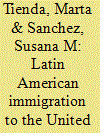

|
|
|
|
|
| Publication |
2013.
|
| Summary/Abstract |
This essay provides an overview of immigration from Latin America since 1960, focusing on changes in both the size and composition of the dominant streams and their cumulative impact on the U.S. foreign-born population. We briefly describe the deep historical roots of current migration streams and the policy backdrop against which migration from the region surged. Distinguishing among the three major pathways to U.S. residence - family sponsorship, asylum, and unauthorized entry - we explain how contemporary flows are related both to economic crises, political conflicts, and humanitarian incidents in sending countries, but especially to idiosyncratic application of existing laws over time. The concluding section highlights the importance of investing in the children of immigrants to meet the future labor needs of an aging nation.
|
|
|
|
|
|
|
|
|
|
|
|
|
|
|
|
| 13 |
ID:
125151
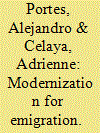

|
|
|
|
|
| Publication |
2013.
|
| Summary/Abstract |
This essay reviews existing theories of professional emigration as background to examine the present situation. Classical theories of the brain drain neglected the possibility that immigrant professionals would return to their home countries and make significant investments and economic contributions there. They do, in fact, with beneficial consequences for the development of these countries. The advent of the transnational perspective in the field of immigration has helped clarify these dynamics, while identifying the conditions under which professional cyclical returns and knowledge transfers can take place. Implications for the future attraction of foreign professionals by the United States and other advanced countries are discussed.
|
|
|
|
|
|
|
|
|
|
|
|
|
|
|
|
| 14 |
ID:
125149


|
|
|
|
|
| Publication |
2013.
|
| Summary/Abstract |
In the next quarter century, North American and Western European societies will face a profound transformation of their working-age populations as a result of immigration, combined with the aging of native majorities. These changes will intensify the challenges of integrating the children of lowstatus immigrants. Abundant evidence reveals that most educational systems, including that in the United States, are failing to meet these challenges; and sociological theories underscore these systems' role in reproducing inequality. However, the history of assimilation in the United States shows that native-/immigrant-origin inequalities need not be enduring. An examination of variations across time and space suggests educational policy changes and innovations that can ameliorate inequalities.
|
|
|
|
|
|
|
|
|
|
|
|
|
|
|
|
| 15 |
ID:
125142


|
|
|
|
|
| Publication |
2013.
|
| Summary/Abstract |
In contrast to earlier waves of immigration, the post-1965 Asian immigration to the United States has not spawned an exclusionist backlash among native whites. Rather, the new Asian immigrants and their children are rapidly gaining access to the American mainstream. Whether in integrated residential communities, in colleges and universities, or in mainstream workplaces, Asian Americans' presence is ever more the rule, not the exception. The success of so many Asian American immigrants suggests that race may not be as decisive a factor in shaping socioeconomic attainment as it was in the American past; civil rights reform has been incorporated in a more inclusive American mainstream. As a group in which those of legal status predominate, Asian Americans have enjoyed more open access to mainstream institutions, paving the way to their rapid assimilation.
|
|
|
|
|
|
|
|
|
|
|
|
|
|
|
|
|
|
|
|
|